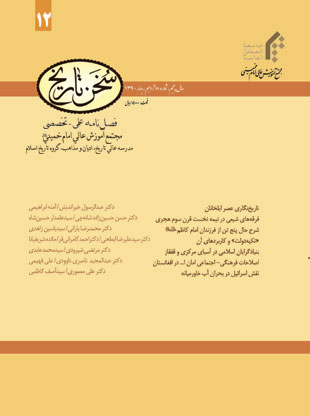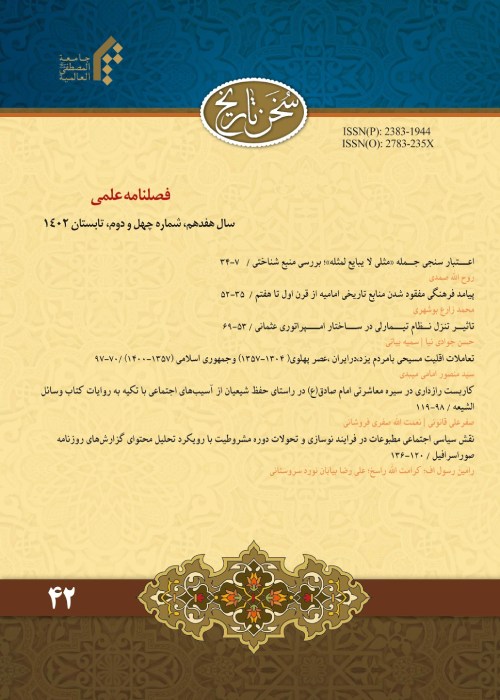فهرست مطالب

نشریه سخن تاریخ
پیاپی 12 (بهار 1390)
- تاریخ انتشار: 1390/07/17
- تعداد عناوین: 8
-
صفحه 5
-
صفحه 63
-
صفحه 121
-
صفحه 151
-
Page 5The historiography background of Illkhanid era along with the notable and outstanding works visualizing the different aspects of that epoch possesses identifying elements. Since such works have been composed at the intense period of Mongolian invasion and their dominance on Iran (as a non-native nation and alien with the dialectic situation of Iran and Iranian) it needs reflection and contemplation. Thus these identifying sources deserve to be deliberated upon with curious, precise and profound appraisal.This element of historiography can outstandingly be found in the works of historians such as Khowjah Rashid al-Din Fazlullah Hamadani (Jami Al Tawarikh) and in the work of Jawini (Jahan Gushai Jawini). These works have a lot say about the subject. While in the works such as Nizam Al Tawarikh the system of histories done by Abdullah b. Umar b.Muhammad known as Baizawi there seems no indication of the topic and this work due to being brief has always faced lesser attention of the researchers. Thereby, the present article considering the characteristics of this eras historiography would study and shed light to the text of Nizam Al Tawarikh with a new profound vision.
-
Page 19
The first half of the third century (A.H) was a difficult time for the Shiism, because from one hand they had the pressures of the governmental administration and from other hand the advent of sects and ramifications have doubled the difficulties. The leading Shiite sects in this period were Zaydiyya (Zaydis), Fatahiyah, and Waqifiyah having remarkable role in the developments of that era. The Zaydiyya sect was more important than all for they had activities in political sphere and revolted against the Abbasid rule. Though most of them ended to sever defeats but with the support of such risings they continued their growth and upsurge and in the long run they succeeded establishing a state in Tabaristan. From other hand they had remarkable scientific activities. The prominent personalities such as Qasem Rasi found the space to flourish who was the pioneer of the Zaydiyya school of thought. Waqifiyah is another faction living in the Shiite community and due to their influence was scientifically more active than the rest of the cliques. Their major activity was to spread the traditions related to Mahdism. Ismailia was busy acting in this period in a low profile policy but nothing is recorded of their activities. Fatahiyya was another sect who despite suffering perversions had significant role in the Shiite traditions. This paper is going to examine the backgrounds of afore mentioned Shiite sects in this half a century particularly the Zaidis who used to manage simultaneously the political and scientific activities.
-
Page 37Some few remarkable researches have yet been arranged about Imam Kazim's male sons. The present researches are more likely monographs that would naturally include some famous sons of Imam Kazim such as Ahmad b. Musa, Hamzah, Haroon, and Hussein b. Musa (a.s) rather than all his male sons. Thus there are plenty of questions that need to be responded. One of those questions that have been raised about them is their tombs and shrines which are mostly located in Iran. Sometimes there are several separate shrines in different cities of Iran for one of Imam Kazim's sons; like Imam Zadeh Haroon, Hamzah, Muhammad, Hussein and Abdullah. In this research the biographies of some five sons of Imam Kazim (a.s) would be cited and the different tombs ascribed to them in Iran and Iraq and other places are studied.
-
Page 63
Lamentation rituals and expression of grief for the martyred figures of Karbala has been one of the long-standing ceremonies of Iranian community particularly when Shiism was officially pronounced. More exclusively it was rated highly and widely in the Qajar era for acquiring people's legitimacy. In this period every class and category showed interest to hold mourning sessions and they were trying to earn the worldly and the life hereafter rewards and leave a good name behind through constructing and dedicating religious theater. At the time of Naser al-Din Shah 's reign the sessions held for lamentation boomed and grew vigorously. In the year 1290 A.H, on the basis of Qajar's king decree a religious theater was constructed for the very purpose by the engineers and architects. But this period lasted little and the ceremonies suffered their downfall with the demise of Naser al-Din Shah. And it was Reza Shah who even outlawed holding such ceremonies. In the year 1325 (solar calendar) the order of destruction of the governmental religious theater was issued. The present article would deal with the lexical meaning of governmental religious theater, its construction, technical characteristics, the method the mourning ceremonies were held in and the next applications and utilities it had.
-
Page 81The issues such as emergence of fundamentalists in Central Asia as a real threat and the concerns emanating from the very danger in the region, the way the Al Qaeda organization and Taliban enter the Caucasus and Central Asia, the intervention of America and foreign powers, analysis of the role played by Iran and Saudi Arabia in different political, cultural and ideological aspects in the regional countries are and form the important topics of the contemporary history of the Islamic world. The Saudi Arabia's role has ended to emergence of fundamentalist movements and instabilities in the region bringing about the intense reactions of the religious scholars and political leaders of the regional countries. Moreover, the factors behind the creation of extremist groups in Azerbaijan need to be debated. The article at hand tries to explore the Islamic fundamentalists who due to adherence of the extremist groups such as Salafis, Al Qaeda and Taliban and the intervention of foreign powers such as America have erupted frustration and dissatisfaction of the people, the religious scholars and the political leaders. And it would also analyze which of the two important Islamic countries of the Islamic republic of Iran and Saudi Arabia have been nearer to the political and Islamic goals in the region. Which country could manage to do his role while being away from the violence and dissention of the people of the region?
-
Page 99The socio-cultural reformation of Amanullah in Afghanistan is the mostextensive aspect of his reformations launched for modernization of the country and with no doubt it can also be counted as the most effective part in the aftermath of reformation. The importance of the discussion lies in the point that for the sake seeking modernity and renovation of Afghanistan the socio-cultural reformation has been put into effect as an infrastructure of political, cultural, and socio-economic development; though this part was also termed as the basic reason in conclusion of reformation. The very writing is an effort responding the question that how and in what backgrounds did Amanullah’s socio-cultural reformation get form? Finally it has been concluded that [his project has failed] for having no suitable archetype in launching reformation and was only duplicating superficial manifestations of the western culture without considering the Afghan people religious values and social rites and norms. This point as the most essential reason in the conclusion of reformation spells out the role of socio-cultural reformation.
-
Page 121In today's world water is a matter of life and death and has a crucial position. The countries invest phenomenal amounts for providing water and create alternatives to resist water wastage. In our contemporary epoch the crisis of water has just turned to one of the most significant international challenges and the Middle East countries being one the world’s most extremely dry locations are the canon of this global challenge; in a manner that the next war in the middle east would be the war of water and it can be changed to a more strategic and decisive capital than the oil. The moment the usurping Israeli regime came into being onward, has taken steps to expand and seize the regional water sources; because it faces with extreme scarcity of water. Water for Israel is more pivotal and far beyond than the items of development because water is associated with its core existence. The existence of Israel depends on water sources of occupied regions and without dominating those sources it cannot extend its life. So this regime caused the water crisis of the region. The present article has tried to prove the hypothesis that Israel has the main and key role in the water crisis of the Middle East.


